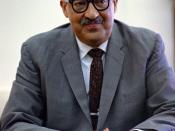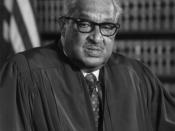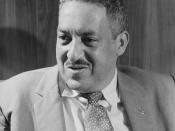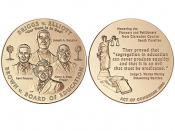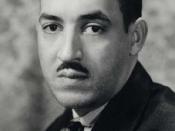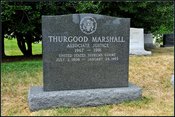John Mason "Separate but Equal" Segregation was ultimately meant to be an equal opportunity for the African American. It was a sensitive but very real reality in the 1950's. The separation of whites and blacks damaged many young students for life. The movie "Separate but Equal" illustrates segregation during this time. It shows the inequality that segregation carries and how it was abolished.
The movie started out in a small colored school in Clarendon County, South Carolina. Reverend J.A. Delaine watched as one of his students started his journey home. As the student was walking down the road a white only school bus drove right past the colored student. This particular student had to walk many miles to and from school with no bus transportation available.
This is when Reverend Delaine decided that he has seen enough. He went to the Summerton school board Chairman R.W.
Elliot to talk about getting a school bus. Elliot told Reverend Delaine that there was not enough funding to provide the colored schools transportation. Reverend Delaine then decided to do an investigating on the funding of the separate schools.
Reverend Delaine found that the school systems were spending $179.00 on every white student, while only spending $43.00 on every colored student. With this information Reverend Delaine decided to use the law. He got a lawyer and wrote a petition to make the schools an equal opportunity for everyone. Reverend Delaine then contacted the National Association for Advancement of Colored People.
A man named Thurgood Marshall, one of the persons that headed the NAACP, decided to go down to Clarendon County and see what exactly he could do. Marshall talked to the colored citizens of Clarendon County and said in order for them to take the case in front of the court, they needed at least 19 signatures on the petition. After Marshall left Reverend Delaine starting going around and talking to people about the petition. There ended up being over 60 signatures on the petition, plenty to make a good argument in front of the court.
The case was heard in front of a three-judge court due to the question of segregation. Marshall had professionals evaluate colored students and proved that segregation was damaging them psychologically making them feel inferior to the white student. He also argued that about the schools being unequal. Noting that the school board was spending $179.00 for every white student and $43.00 for every colored student. The Clarendon County School Board stated that the funding was unequal and that there will be something done about it. They said the school board needs time to gradually make the colored schools equal. The state court granted the Clarendon County school system time to make these changes.
This was not a very significant turn around, and Marshall decided that separate but equal was not good enough. He wanted to take the case Briggs verse Elliot to the Supreme Court. He felt that he had a small chance of ending this madness and desegregating the schools.
During all this time the whites are shown the hatred and fear that they carry toward the African Americans. Many colored people lost their jobs and way of life. Harry Briggs, the first to sign the petition lost his job as a mechanic. Reverend Delaine was replaced and fired from the school. White people also burned down Reverend Delaine's house, and the fire department drove by and said that they could not help him. They told him that his house was just on the other side of there jurisdiction and drove off. Thurgood Marshall now realized that these people were risking their lives so their children can live equally among the whites.
The Supreme Court decided to hear five cases collectively in 1952 making the issue of segregation national instead of just in the south. The school board hired John W. Davis to argue their case. Davis had argued and won more cases in front of the Supreme Court than anyone and was very well respected.
Both Davis and Marshall argued their case. Marshall was surprised and stunned by one of the justices of the Supreme Court. This justice cut him off and led him away from his argument. Because of this Marshall's argument was not where it should have been, it was led away and dampened by this Justice of the Supreme Court.
After much discussion the Supreme Court could not decide what to do with the argument of segregation. So they decided for a rehearing in 1953, bringing upon the question of what our forefathers truly meant by writing the 14th amendment. Marshall seen this as a second chance and was not about to let it go without a valiant fight.
Marshall brought in historians and scholars from all over the country to find something on the writing of the 14th amendment that stated segregation is not equal. He had a task at hand that people thought could not be done. The NAACP went to great efforts for the rehearing of this case. Secretaries and others went without pay to aid in the call of equality. Marshall's wife even had to sell jewelry to buy food for supper.
Through out the case Marshall found that his wife was diagnosed with cancer. This helped Marshall to fight for what he thought was right. We wanted his wife to see the changes that were coming to our country. Marshall kept plugging away day and night trying to find something that would help them win the case.
In September of 1953 President Eisenhower appointed Earl Warren, Governor of California to the new Supreme Court Chief Justice. It was said that he was appointed due to an owed favor. This worried the NAACP because they knew nothing about Warren. They did not know if he was for or against segregation.
Marshall was much more well prepared for this hearing. He was quick with his answered and gave a strong argument. He bent his argument to get his point across about segregation and how unequal separate schools truly are. Now they once again had to wait for the decision of the Supreme Court.
While in the process of deciding, Chief Justice Jackson took a trip. In his trip he had a colored driver. The turning point of the case was when he came back to the car and his driver was spread across the seat asleep. When Jackson asked why he was sleeping in the car he replied that there was not a black hotel for many miles. That the white hotels would not let him rent a room. This is a man that risked his life and fought for his freedom.
Jackson started to see how life was really like for the colored people. He decided to talk to the other Justices and persuade them to go against segregation. He wrote documents and had everyone read them explaining why segregation should be abolished.
During this one of the Justice of the Supreme Court went to the hospital for a heart attack. This was another turning point in the case. It gave this certain Justice a new look at life. It had a whole other view point on segregation.
The decision was made, everybody was called for the court hearing. At 12:52 P.M. on May 17, 1954, the Supreme court unanimously decided to abolish segregation. Marshall had won his case and ended the doctrine "Separate but Equal." ?
